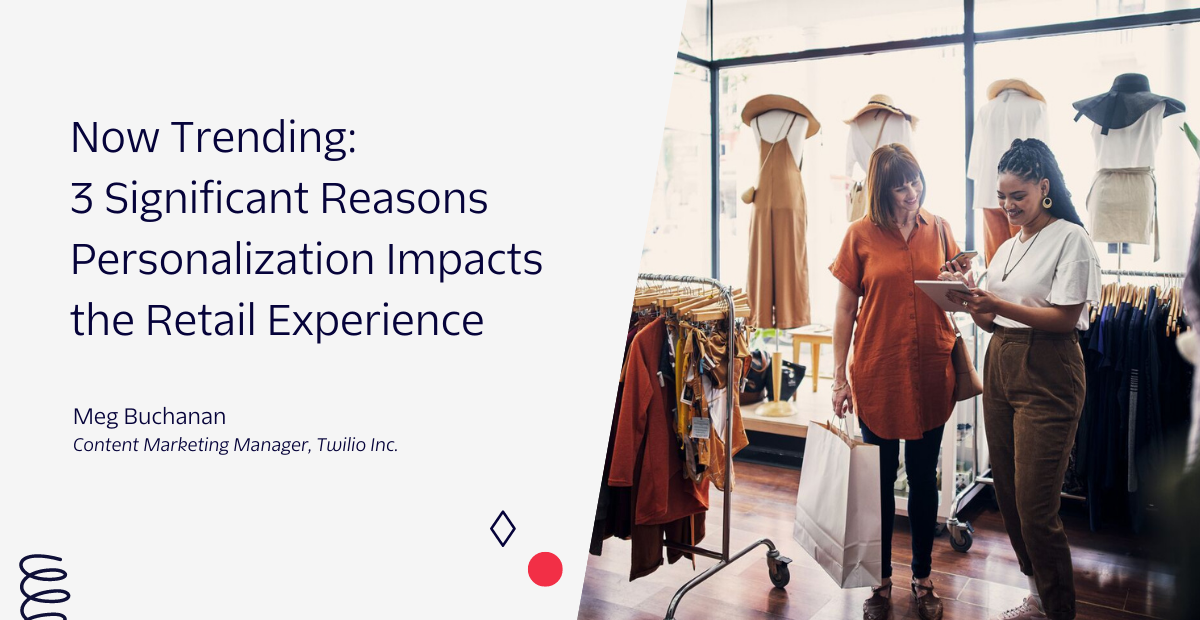Now Trending: 3 Significant Reasons Personalization Impacts the Retail Experience
Time to read: 5 minutes

To say personalization is an important part of the retail experience is not some newfound truth. The sky is blue. A week has seven days. Rain makes things wet. Duh. And since we're not in the business of recounting the obvious to our customers, we went beyond the basics in our 2022 State of Personalization report.
Why? Because while you might understand that personalization is important, articulating how it makes a difference in your customer’s shopping experience isn’t quite so obvious. Below we’ll share three reasons why investing in customer personalization is key to long-term loyalty and your enduring success.
Reason #1: The great data dilemma
Just 40% of consumers say they trust brands to keep their personal data secure and use it responsibly.
The challenge: Let’s start with the elephant in the room. Your customer wants personalized experiences. You know that. They also want to know how and why you’re using their data. You also know that. The question is, if a customer wants a personalized retail experience, how can a business collect data in a more forthright and seamless way to deliver that to them?
The solution: In short: First-party data. You’ve seen data-powered experiences on your Amazon homepage or Spotify suggestions. First-party data enables brands like these to build accurate customer profiles based on their habits, preferences, and purchases within the business's apps or websites. And because the data isn't coming from a third party, it eases customers' minds. In our 2022 State of Customer Engagement Report, 85 percent of consumers said they want brands to make use of only first-party data when creating personalized services.
And It doesn’t have to be limited to ‘if you like this, you might like this’ experiences. Get creative with first-party data to make your customers’ shopping experiences stand out.
The retail hot take: A great example of using first-party data to power a more personalized experience is Rebag’s AI-powered chatbot, Clair, which employs more than six years of customer data to simulate an experience similar to a ‘Shazam for purses.’ Sellers can scan the bag they’d like to get appraised straight from their phone in the comfort of their homes. Clair then taps handbag data across 50-plus brands to ID the designer, bag model, and typical resale price.
As retail organizations race to find new ways to interact with their customers, this type of technology stands out—especially because Clair is a learning bot. In time, she’ll also be able to learn from her mistakes and work to spot fake handbags in place of real ones. This is particularly innovative because it’s a service the human eye can’t provide from afar, and it gives customers a trustworthy and secure experience that wouldn’t be possible without harnessing existing customer data to improve upon itself.
Reason #2: The omnichannel challenge
Only 35% of companies feel they are successfully achieving omnichannel personalization in 2022.
The challenge: Your customer wants to be reached when and where works best for them with content they genuinely care about—and you want to give them that autonomy! But actually delivering an omnichannel strategy for a cohesive shopping experience is a different story. You know you need it, but when it comes to actually integrating it within your existing platform… gulp. You’re not alone. The majority of businesses surveyed in our report shared the same frustrations due to technological and organizational constraints.
The solution: As tempting as it may be to keep adding on top of your existing legacy platform, it may be time to take a hard look at whether this singular approach to an omnichannel strategy is actually working. Starting from scratch may seem daunting, but finding a platform that can add channels over time (instead of trying to plug in several together) can be a smarter long-term solution to enabling the personalized experiences retail customers have come to expect.
Furthermore, every time your customers interact or do business with your brand, they are giving you a wealth of information on what they like, don’t like, and need. With siloed channels, your brand fails to capture this information, making it very difficult or even impossible to deliver hyper-personalized experiences that pick up exactly where a customer left off. Having one system in place to capture all of their information makes their experience better.
The retail hot-take: Filling prescriptions can be a real challenge. Walgreens is a great example of how to use first-party data within omnichannel marketing to create customized, cross-channel experiences that make the refill process easier.
Using the Walgreens app, a customer can scan the barcode on their prescription bottle and automatically generate the refill for pickup at their local store. An individual can even order a refill by replying to a Walgreens reminder email, or simply calling up the pharmacy.
This kind of approach signifies the continued shift in the industry of prioritizing automation and omnichannel communication. No longer is there a fear of personalization taking a back seat without in-person service. The speed, precision, and shopping support that automation has enabled have improved retail experiences significantly. Now, we expect to see deeper personalization that continues to improve as new channels and technologies emerge.
Reason #3: Hyper-personalization is the future
Nearly half (49 percent) of consumers say they will likely become repeat buyers after a personalized shopping experience with a retailer.
The challenge: It’s no longer enough just to make a simple effort to personalize your customer’s experience with your retail brand. With 72 percent of consumers now saying they only engage with marketing emails tailored to their personal interests, it’s in every business’s best interest to figure out how to safely harness user data to create more personalized experiences for their customers. This isn’t just about mere preference. It’s about customer loyalty and long-term business survival.
But figuring out how to achieve hyper-personalization once again can feel incredibly daunting. Without the correct tools to automate information in real-time and segment your audiences strategically, your user data is left to go to waste.
The solution: Seamless, secure, hyper-personalized experiences where your customers can be contacted exactly how they preferaren’t that far in the future. With the integration of customer data platforms and CPaaS (communication platform as a service), retail businesses will soon be able to deliver this kind of experience to their customers, even if they aren’t multi-million dollar companies. In the meantime, retail companies can work on aggregating their customers' data in one secure place (like a customer data platform) to harness the power of omnichannel.
The retail hot take: Vacasa vacation rentals is working to do just that by developing an intelligent customer engagement strategy that delivers custom messaging to travelers on the go. Taking the friction out of the check-in experience by letting customers communicate via email and SMS, Vacasa was able to increase their guest booking by 3X with personalized email campaigns.
Automated, seamless, personalized communication not only enhances your customers’ experience with your retail brand. It very literally increases your bottom line and keeps them coming back for more.
Create a better retail experience in 2022
In comparison to other industries, retail has already been embracing and utilizing personalization with the rise of e-commerce over the past 20 years. With the pandemic, however, retail companies large and small have a huge opportunity to utilize their data from their online consumers to drive customer engagement even further.
Meg Buchanan is a Colorado native, a Kansas Jayhawk, and a proud multi-tasking millennial. As Twilio's Content Marketing Manager, she has more than seven years of experience writing for both agencies and in-house brands on topics from healthcare to hospitality.
Related Posts
Related Resources
Twilio Docs
From APIs to SDKs to sample apps
API reference documentation, SDKs, helper libraries, quickstarts, and tutorials for your language and platform.
Resource Center
The latest ebooks, industry reports, and webinars
Learn from customer engagement experts to improve your own communication.
Ahoy
Twilio's developer community hub
Best practices, code samples, and inspiration to build communications and digital engagement experiences.


